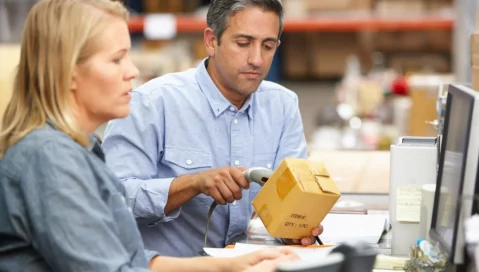How To Survive as Consumer Delivery Trends Evolve
How To Survive as Consumer Delivery Trends Evolve
How To Survive as Consumer Delivery Trends Evolve
23 Sept 2021
Aptean Staff Writer
Home delivery has exploded in the last few years, and the pandemic has accelerated that trend even further. You can now order almost anything online and have it delivered to your home. You can get alcohol and a gourmet meal, clothes, furniture, pharmacy items, and even groceries. In 2020, consumers spent $861 billion dollars with U.S. merchants, a whopping 44% increase year over year. Online spending accounted for 21.3% of retail sales for the year. In 2019, online sales were only at 15.8%, so 2020’s stats show a marked leap.
Part of this was due to the pandemic and nationwide shutdowns. During the height of the pandemic people couldn’t, or wouldn’t, go out to retail stores, so they shopped online instead. But a great part of this is due to changing consumer habits and an altered retail landscape. Amazon is still the online retail leader—no surprise—but other retailers, such as Wal-Mart, Best Buy, and Kroger, grew online sales by 85% in 2020.
This growth in ecommerce is a boon for logistics and delivery companies. By 2025, the number of packages delivered around the world is expected to climb to 200 billion, up from 90 billion in 2018. As your company prepares for the “next normal”, how can you plan to meet and exceed changing customer expectations? And what are those expectations?
Let’s dive into what the current consumer trends are, and how your delivery company can succeed in this ever-changing retail landscape.
Current Consumer Trends
1. Scaling Back:
More than one-third of Americans stated that their income has been negatively impacted by the pandemic. Because of this, spending on discretionary items has dropped, while spending on groceries, in-home entertainment, and household supplies has shot up. Internet providers in particular have experienced a surge in customer upgrades as more people work, learn, communicate and live through remote means. Analysts predict that these behaviors will remain stable even after the pandemic wanes. Many organizations are reorienting their operations to a fully digital or hybrid staffing model. Also, many consumers may prefer to use digital services due to embedded behavior from the pandemic.
2. Dissolving Brand Loyalties:
Companies that did not make the digital transition quickly enough found even die-hard loyalists abandoning them. Lack of availability, safety concerns, and sustainability issues have caused many consumers to switch brands. If consumers find the new brand acceptable—or perhaps better—than the previous brand, the switch may be permanent. As retailers grapple with stocking concerns, consumers have been forced to seek alternatives. In a COVID-19 world, consumers cite availability as the number-one reason why they sought out new products or new retailers.
3. Safety Concerns:
It’s not surprising that the pandemic has fostered an upsurge in cleaning and sanitation concerns. 17% of consumers reported switching from their normal stores due to hygiene issues. In addition, the pandemic has highlighted the importance of safe delivery channels, including curbside pickup and contactless delivery options. Companies must implement policies and processes to enable safe distances, sanitize surfaces and products, and communicate with customers about these procedures at every step.
4. Digital Excellence:
Consumers have become increasingly channel-agnostic. This means that they now expect the same—or better—experiences shopping online as shopping in-store. Having intuitive, user-friendly digital channels will help your company meet changing customer expectations. It will also help you be nimble and prepare for future industry disruption. Now is the time to invest in building or augmenting your digital capabilities in order to offer a seamless, consistent customer experience regardless of the channel. Digitization of processes is no longer an option; it is a necessity.
So how can your logistics company compete in this new landscape? With consumers expecting fast, safe, reliable delivery, you need an enhanced customer experience more than ever. Speed isn’t enough if the product arrives dirty, incorrect or damaged. For example, mattress companies have started a growing home delivery option; but if the package arrives damaged or the customer receives the wrong item, the customer experience suffers. In the post-pandemic era, distribution and logistics are crucial, so your company needs to capitalize on the shift.
Here are three strategies for thriving in our next normal and beyond.
1. Digital Transformation Is Key
The pandemic has made delivery services more complex. This is due not only to an exponential increase in volume, but also to increased demand coupled with supply chain disruptions. So, to ensure timely delivery services, your company needs to digitize and streamline all processes so that there are no missteps between when an order is placed and when it arrives to the customer.
That’s a tall order--and one you cannot hope to achieve with only spreadsheets or rudimentary tools. If you want to maintain profitability, you’ll need specialized distribution software to keep everything organized and optimized. The ability to adapt requires businesses to think about “what-if” scenarios, and plan potential responses. You need to be ready to pivot, no matter what happens. The right solution makes this easy by providing the data and insights necessary to spot changes and then the tools required to act on them swiftly and efficiently.
In a notable real-world example, a variety of new mattress companies sprang up, all offering home delivery of their mattresses. Due to the burgeoning number of people working remotely, office supply companies offered free home-office design tools, and then offered customers the option to have safe, in-home delivery and assembly services. What is the common thread here? These businesses used changing customer data to pivot their operations. The data they got allowed them to meet the demands of their customers and communities.
Going digital with distribution software to streamline your fleet operations guarantees that you can pivot to whatever delivery model ensures the most efficient operation. You can efficiently route deliveries to meet fluctuating demands. You can seamlessly communicate with your team and your clients across the transportation operation. And you can manage delivery protocols to keep drivers safe. For example, signed proof of delivery options have been superseded by photos of delivery. The best part? With routing and scheduling software, these processes are optimized—boosting efficiency and saving you money.
2. Optimize the Last Mile
Did you know that the final miles of any delivery constitute about 53% of the cost? For you, that means optimizing that distance is crucial. Consumers today expect real-time delivery tracking. If your business isn’t providing tracking information, the time between placing their order and receiving their items seems endless. And, as a result, increases the number of "where is my order? ' inquiries to your customer service team.
What is the last mile problem? Inefficiency. The reason is that in that final leg, there are greater stops and smaller drops. In large cities, the problem is compounded with constant traffic. In rural areas, delivery points may be miles apart, and harder for drivers to access. Add these issues to the meteoric rise of ecommerce, which means more delivery trucks on the road each day, and more possible competition for you.
Last mile logistics are the one place where it is imperative to have the most efficient, cost-effective, and transparent delivery. How can you achieve this? Robust routing and scheduling software. This type of technology ensures that you have complete visibility of delivery delays, exceptions or missed appointments. Final mile route optimization is a snap. The software ensures that your drivers execute delivery in the most cost-effective and time-efficient sequence. You can also put in customized parameters, such as:
Driver schedules and PTO
Traffic patterns and road closures
Maximum route distance or maximum hours for DOT regulations
Unique customer requirements and order attributes
3. Keep Your Drivers Happy
Your drivers are the lifeblood of your company—without them, you cannot survive. You also need to keep them safe and keep them to a strict Hours of Service schedule. You want to keep squabbles to a minimum and ensure that your team gets treated fairly. How do you juggle HoS regulations, safety concerns, personal preferences, and still get deliveries out on time, every time?
The answer: Route planning and optimization software. With Aptean’s Routing & Scheduling solution you get improved function in every aspect of your operation. Here’s how.
Optimized, yet operationally feasible routes.
Maximize driver, asset, and equipment utilization.
Minimized mileage, resulting in lower transportation costs.
Predictable, reliable routes, leading to increased customer satisfaction and driver retention.
You can even factor in your team’s personal preferences. Maybe your driver is a single dad that gets his children on Fridays and cannot work. You have a driver that likes to end near their home. You can add in any number of personal considerations, and alter the schedule accordingly. All this, and you can still manage an efficient route plan.
Home delivery has exploded in the last few years and customers expect efficient, safe, rapid delivery. To survive, you must exceed customer satisfaction with every delivery.
At the same time, you have a host of operational challenges that are growing in complexity—rising costs, driver shortages, and increasingly convoluted supply chains. How does this affect you? To keep your company competitive, you must boost efficiency and streamline costs wherever possible.
Sounds impossible, right? It’s not—you just need the right distribution software. From routing and scheduling software to proof-of-delivery systems, switching from manual tools to purpose-built solutions will allow you to surpass customer expectations and overcome operational complexities. This means that your company will not only survive in the new era, but thrive.
In the post-COVID era, logistics companies will be at the forefront of economic recovery. But only those companies that have optimized and automated operations will be able to survive.
Are you ready to take the first step toward enduring success? Talk to one of our logistics experts to learn how.
Prêt à transformer votre entreprise ?
Nous avons les logiciels sectoriels spécialisés dont vous avez besoin pour développer votre entreprise.



